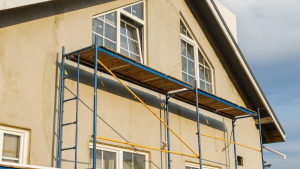The R-value of insulation is a number that shows how well it slows the flow of heat into and out of a building. If you want to get new vinyl siding for your house, you need to know everything there is to know about this term. You might have come across this term while doing research. The experts at CMB Wayne Stucco & EIFS can tell you more about the R-value of vinyl siding and other things to consider when choosing a new exterior for your home.
All About the R-Value
When a building has enough insulation inside and outside, neither air nor moisture can get in or out. The “R” value measures how well a material stops heat from moving through it. The R-factor is a way to measure how well a material prevents heat from moving through it when it is put between two plates.
In the lab, tests are done on a square foot of material that is an inch thick and has an area of one square foot. The material is a degree cooler on the outside than on the inside. The rate of heat flow in BTU/h can be used to figure out the thermal conductivity of a material.
When you multiply the R-factor by the thickness of the material, you get the R-value. The consistency and R-factor of insulation affect its R-value. For example, if the thickness is 1.5 inches and the R-factor is 2, the R-value is 3. The R-value of material shows how well it keeps heat in and cold air out during the winter and how well it keeps heat in during the summer.
Discussing Interior Insulation
Most people think of a roll of smooth fiberglass or spray foam on the walls when they hear the word “insulation.” Even though this insulation works, it may still let air leak out, which could cause heating and cooling costs to be higher than needed.
Most wall insulation is put in the space between the studs, not the studs themselves. Studs can take up as much as a quarter of the area on a home’s walls. Thermal bridging is when these barriers allow heat to move inside your house to the outside. Your home may not be as warm as it could be because of these energy leaks, which may also cost you money.
Vinyl Insulation for Interiors
Insulated vinyl siding outside the house protects these studs and other areas from heat transfer and drafts, which cuts down on energy loss. The R-value of high-end insulated vinyl siding is between 2.0 and 4.0. This could be different, though, depending on the chosen type, brand, and size of siding.
The R-value of most vinyl siding is 0.61. High-quality vinyl siding has a higher R-value than many other building materials, even if it isn’t insulated. Here are some typical R-values for common building materials:
Fiber cement – 0.37
Stucco – 0.40
Brick veneer –0.44
Stone veneer – 0.11
Talking to a seasoned contractor about your needs and how you want your house to look can help you understand R-value and determine which material might be best for you.
More Advantages of Vinyl Siding
Standard vinyl siding and insulated vinyl siding each have their benefits. Insulated vinyl siding has a higher R-value, which can help your home use less energy.
Instead of painting, caulking, or staining vinyl siding, all you have to do to clean it is spray it down with water and a mild detergent. It costs little to keep up because it doesn’t need any maintenance.
High-quality vinyl siding won’t show any wear even when it’s in direct sunlight or when it snows a lot. On top of that, it doesn’t get damaged by bugs or water so it won’t rot.
You can buy vinyl siding in different colors and styles that look like other materials, wood, and stone. It can be used for many things outside because it is flexible.
Since first impressions are so important, it is just as important that the siding is well insulated and has a high R-value as it looks good from the outside. Installing vinyl siding can improve a home’s curb appeal and make it easier to sell. Putting vinyl siding on your house is an excellent idea if you want it to look unique or if you plan to sell it soon.


